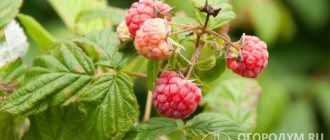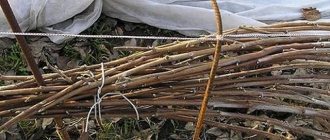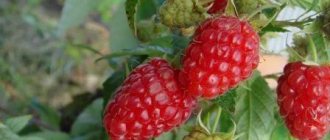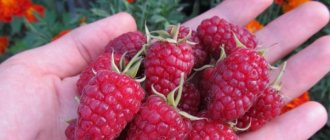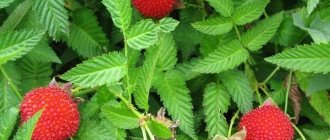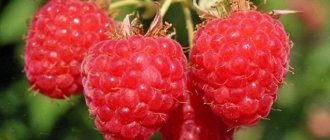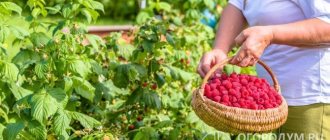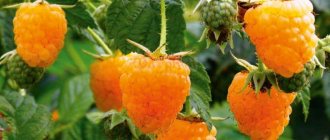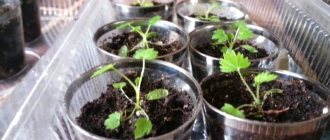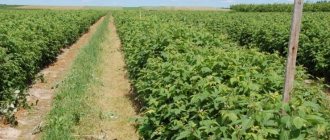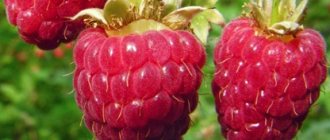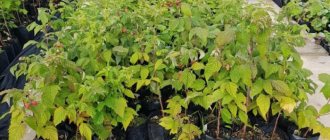Description of the variety
"Generalissimo" is one of the newest large-fruited raspberry varieties , forming a medium-sized bush with very powerful, strong and thick shoots. The thorniness of the shoots is high, along the entire length. Shoot-forming ability is average. Young shoots are represented by 5-7 shoots. Each bush produces no more than ten replacement shoots.
The variety is characterized by excellent productivity. Average yields are 5-6 kg of large berries. Complete pruning of shoots in the autumn helps to increase yields by 25 - 35%.
The berry is large, up to 4 cm long. The average weight of a commercial berry reaches 11 g . The shape of the berry is blunt-conical, the surface is bright red. The berries do not fall off when ripe. The harvested crop is highly transportable. The maximum yield is observed when this variety is cultivated on fertile soils in the southern regions of our country.
How to plant raspberries (video)
However, when growing, it should be remembered that the variety produces a relatively moderate number of replacement shoots and root suckers, which not only simplifies plant care to a certain extent, but also significantly reduces the amount of high-quality planting material. If it is necessary to carry out propagation, agricultural practices should be followed to increase the number of offspring.
Remontant varieties of raspberries annually produce a generous harvest of large berries, and one of the best types is the Generalissimo raspberry. The bushes are not picky about care, but bear fruit for a long period of time, and the taste and commercial characteristics of ripe fruits attract many gardeners. A detailed description of the Generalissimo raspberry, the pros and cons of the variety, as well as the main features of its planting and cultivation are presented in this article.
Read also: Battery-powered electric boat pump
Landing requirements
Remontant raspberries of the Generalissimo variety need fertile light soils, without high groundwater levels. The area should be well lit throughout the day. The most suitable place for planting seedlings is the south side of the garden plot, near buildings.
Seedlings with an open root system are planted in autumn or early spring, even before the onset of the active growing season. Planting material with a closed root system can be planted throughout the entire growing season.
Row planting method : 1.5-2 m between rows and 0.5 to 1 m between plants. The tape method of planting remontant raspberries: in 2-3 lines and a distance of 70 cm, and between the tapes - from 1.5 to 2 m. With the bush method , plants should be placed in the corners of squares 1.0 x 1.5 m.
Preparing for winter
Experienced gardeners cover raspberries for the winter. Before this, it is given abundant watering so that the roots can withstand the upcoming cold weather.
As soon as the last leaves fall, but always before the first snow, winter shelters are made. The soil is mulched with peat, compost, straw, with a layer of 5 to 10 cm.
If the regions do not have completely snowy winters, then the bush is covered with spandbond or other non-woven material and fixed.
Ways to increase yield
Remontant raspberry varieties confidently occupy leading positions in plantings in household plots and garden plots, due to the ability to harvest from such shrubs twice per season. Yield indicators are strongly influenced by such parameters as the number of fruiting shoots on each bush, the number of ovaries on the shoot, the average weight of the berry and weather conditions.
To increase productivity and extend the fruiting period of a berry crop, it is very important not only to follow the basic rules of agricultural technology, but also to use some highly effective techniques.
| Event held | Technology |
| The most effective way of pruning annual raspberries today is the method of A. G. Sobolev | It assumes shortening of shoots by 15-20 cm in the summer and minimal shortening of second-order shoots in the spring. Immediately after harvesting the last harvest, all fruit-bearing shoots on the bushes must be cut out at the root |
| Method for thinning raspberry bushes | In the process of thinning a raspberry tree, no more than four or five fruit-bearing shoots should be left per bush of a remontant variety. |
| Effective watering | A large area of raspberry fields requires the use of a drip irrigation system. The main waterings should occur during the period of active growth, flowering and berry formation. The depth of stable soil moisture should be 35–40 cm |
| Fertilizer application | Mineral fertilizers can be successfully replaced with organic matter in the form of diluted mullein or an infusion based on chicken manure with the addition of wood ash |
| Mandatory loosening after watering | When loosening the soil in remontant raspberry plantings, damage to the root system of the plant must not be allowed. |
Raspberries with the sonorous name “Generalissimo” bear fruit abundantly under conditions of high agricultural technology. But even a slight deviation from cultivation technology, according to experienced gardeners, does not have a significant negative impact on the yield of this remontant modern variety.
Features of agricultural technology
Even a novice gardener can grow this variety on his own plot. To do this, it is enough to choose the most suitable place for the bushes, plant the plants correctly and provide them with standard care, which consists of timely watering, fertilizing and pruning.
Important! When grown in regions with cool summers, the number of berries obtained from each raspberry bush decreases by approximately 1 kg.
To harvest a generous harvest of Generalissimo raspberries, you need to notice the appearance of diseases or pests in time, and also carry out a set of preventive measures to combat them. Let's take a closer look at the main subtleties of caring for this variety.
Selecting a location
Before planting Generalissimo raspberry seedlings on the site, you need to correctly choose the most suitable place for them. In unsuitable conditions, heat-loving bushes will bear fruit worse and will also become more susceptible to diseases and harmful insects.
The basic requirements for a site intended for growing this variety are presented below:
- location on the south side of fences or buildings - this will provide the bushes with a sufficient amount of solar heat and protect them from the cold north wind;
- good sunlight - in the shade the berries will grow smaller and their taste will be more sour;
- fertile and light soil - allows the roots of the plant to freely receive air, water and nutrients;
- lack of groundwater lying close to the soil surface - with regular flooding of the beds, the raspberry roots will rot.
Planting and care
Generalissimo raspberries can be planted in late autumn before frost or in spring before the active phase of the growing season begins. Planting young seedlings has no peculiarities compared to other varieties of this crop and can be carried out according to one of the presented schemes:
Important! At least a month before planting raspberries, the soil in the selected area is cleared of plant debris and dug up, and then holes are prepared with a depth of about 0.5 m and a diameter of up to 40 cm.
- in rows, located at a distance of 1.5–2 m from each other, with an interval of about 1 m between adjacent bushes in a row;
- ribbons 2-3 lines placed every 1.5–2 m, with a distance of about 70 cm between adjacent plants in each tape;
- squares, placing seedlings in the corners of a rectangle with sides of 1 m and 1.5 m.
A step-by-step algorithm for planting Generalissimo raspberries is described below:
- Immerse the roots of the seedling in a nutritious and thick mixture of water, fertile soil and mullein.
- Mix the soil obtained from digging a hole with 2 buckets of rotted manure, adding 1 cup each of mineral fertilizers and double superphosphate. Form a mound from the nutrient soil mixture at the bottom of the planting hole.
- Lower the roots of the seedling into the hole, straightening them on the surface of the earthen mound. The root collar should be 3-4 cm above the soil surface.
- Sprinkle the roots with soil and lightly compact it around the plants. Water each bush generously with water.
- When the moisture is completely absorbed, cover the ground around the seedling with a layer of humus or peat.
Video: planting raspberries in spring
After planting, Generalissimo raspberries require standard care. It consists of carrying out the following activities:
- regular watering - during the entire growing season, the soil around the bushes should never completely dry out, and during irrigation it is recommended to deeply moisten it by 35–40 cm;
- shallow loosening of the soil and weeding around the plants - carried out after each watering;
- mulching the soil - helps keep the soil loose and moist longer, slows down the growth of weeds;
- with the beginning of the active growth period in the spring, Generalissimo raspberries are fertilized with an infusion of bird droppings (1 kg of substance per 10 liters of water), diluted with water in a ratio of 1:10;
- the second feeding is carried out after 2 weeks, watering the plantings with a solution of 10 liters of water, 40 g of potassium salt, 30 g of ammonium nitrate and 60 g of superphosphate;
- during flowering, the bushes are watered with a solution of complex mineral fertilizers containing potassium and phosphorus, or an ash solution (1 cup of powder per 10 liters of water);
- Before fruiting begins, a solution of nitrophoska (45 g of fertilizer per 10 liters of water) is applied to each plant.
If the Generalissimo raspberry shoots are pruned at the root in the fall, then the bushes do not require additional fertilizer on the eve of winter.
Did you know? You can make tea from raspberry leaves. To do this, they are rubbed in hands until the juice is released, and then dried at high temperature in the oven.
Disease and pest control
If all of the above recommendations for planting and growing plants are followed, the Generalissimo variety is rarely affected by diseases and pests. But sometimes a gardener makes mistakes in caring for bushes, which can lead to the following problems:
- Purple spot. The disease develops in conditions of high air humidity, and its main symptom is light purple spots on the shoots. Subsequently, they acquire a brown color, the branches of the plant become fragile and stop growing, and the crop yield decreases. To combat this disease, use a 1% solution of Bordeaux mixture, spraying the plantings before and after flowering, as well as on the eve of winter.
- Anthracnose. Small gray spots appear on raspberry leaves with a characteristic purple rim. As the infection spreads, the area of these spots increases, the leaves curl and fall off prematurely, and the berries become deformed and turn black. You can cope with the infection by spraying the bushes with 1% Bordeaux mixture.
- Aphid. Insects are located on the lower surface of the leaf blade of plants and suck out the juice from them. As a result of the pest's activity, the surface of the bush becomes covered with a sticky coating, which serves as an ideal environment for the proliferation of harmful fungus. Raspberries stop growing, their leaves dry out, and the fruits do not ripen. Insecticides are used against aphids (for example, Karbofos).
- Spider mite. This small insect actively reproduces in hot and dry weather in conditions of excessively dense plantings. The mite sucks the juice from the leaves and envelops them in a thin web. The green mass of the bush acquires a marble color and falls off, and the bush dries out completely. Pests can be exterminated using acaricides (for example, Phosfamide).
To prevent the occurrence of the listed diseases and pests, it is recommended to take simple preventive measures:
- follow the recommended seedling planting scheme;
- remove weeds in a timely manner;
- follow the watering and fertilizing schedule;
- loosen the ground around the bushes;
- perform pruning, removing excess and diseased stems of the plant.
Did you know? From a botanical point of view, a raspberry is a cluster of small fruits with seeds that have grown together, which is why in the scientific literature it is called a polydrupe.
Trellis
If Generalissimo raspberries are planted in rows, it is recommended to install trellises along them for gartering the bushes. Under the weight of large berries, the shoots can sink all the way to the ground, as a result of which the fruits become dirty and the branches often break. The trellis supports all parts of the bush in an upright position and provides uniform illumination of the fruit, which has a beneficial effect on the ripening time of the crop.
The basic rules for using trellises when growing Generalissimo raspberries are listed below:
- the structure is placed near the raspberries immediately after planting the seedlings;
- poles up to 1.5 m high are installed along a row of bushes at a distance of 5–10 m from each other - they serve as a support;
- wire or reinforced twine is pulled between the pillars - in the future it will be possible to tie bush branches to it;
- neighboring shoots are carefully fixed on the trellis using twine, directing them in opposite directions at a distance of about 10 cm from each other.
Pruning and wintering
Pruning the bush has a beneficial effect on the yield of this variety. It is produced in spring and autumn after the last portion of ripe berries is collected.
Important! Spring pruning of a raspberry bush should be carried out in sunny and dry weather using a sharp knife or pruning shears.
In this case, you need to adhere to the following recommendations:
- in October, cut off all shoots completely at ground level - this will help increase the number of ripe fruits next year by 25–35%;
- with the onset of spring, new fruiting branches will form in place of the cut stems - no more than 5–7 main shoots are left per bush, and the excess ones are cut off;
- the length of the second-order branches is shortened slightly in the spring, removing twigs growing inside the bush;
- in summer, all main shoots are pruned by 15–20 cm.
Raspberry Generalissimo is characterized by average frost resistance, so it is recommended to cover the plants for the winter. The basic rules for this procedure are:
- before covering the raspberry tree for the winter, you need to water it generously - the roots saturated with moisture will be stronger and will withstand wintering better;
- It is recommended to build a winter shelter immediately after the leaves fall, but before the first snowfalls;
- the soil around the bushes is covered with a layer of mulch made from peat, compost or straw - to protect the roots from frost, the thickness of such a layer should be 5–10 cm;
- if a given region is characterized by a frosty winter with little snow cover, then the raspberries are additionally covered on top with a layer of non-woven material (spunbond or lutrasil), securely fixing it to the surface of the earth;
- In spring, the bushes are freed from shelter after the snow melts.
Harvest raspberries - cultivation
In 2021, all raspberries turned out to be productive, but especially one remontant variety, Generalissimo.
Over two unfavorable years, diseases have accumulated in the raspberry field. We removed the old plantations in 2021. The varieties were updated with new younger seedlings, but without a name. They just took them from friends. The new raspberry patch turned out to be a small area, 3-5 meters in size. We planted in 3 strips. We keep the paths between them free. We remove excess raspberry shoots on them. So that there are no impenetrable thickets.
In the spring, my husband put a thick layer of manure under the bushes. I did spring pruning of bushes. I thinned out the raspberry tree, removing all weak shoots. In 2021, we collected 2 large buckets of berries from a small plot in July. In August, their ripening continues, so we collect 1.5 - 2 liters every two days. While picking berries, I weed the raspberries to remove weeds.
In August, berries affected by the fungus began to appear. In small quantities, but there. To reduce the spread of the disease and improve their resistance to diseases, I watered the soil with an emix solution. I scattered wood ash from the fireplace in the raspberry tree.
It turned out that the small raspberry garden contains different varieties. Some of last year's shoots began to dry out in August and are easily broken off by hand, other bushes stand fresh and green, especially raspberries of the Generalissimo variety.
Benefits of the Tarusa raspberry tree
- Raspberries are unpretentious for planting - there is no need to attach them to a trellis, since Tarusa is a standard variety.
- It has high productivity, which increases over the years.
- Does not require pruning of shoots.
- Resistant to diseases and pests. Even if the tree itself is damaged by some kind of infection, this will not affect its fruiting and the yield will not decrease.
- Tarusa bears fruit all summer without interruption, from the beginning of July to the end of August.
Harvest raspberries - Generalissimo variety
Three years ago I bought one raspberry shoot of the Generalissimo variety at an exhibition in Krasnoyarsk. As a sample, they showed a bush with huge elongated berries, it was impressive. The escape was sold at a high price - 300 rubles.
Previously, exhibitions of agricultural crops were held in Krasnoyarsk in every district of the city. It was possible to buy various seedlings of trees and shrubs. Now for some reason they have stopped holding such exhibitions. But in vain, it was very convenient for people. But in 2021, this deficiency has been corrected, and a company has appeared that sells garden plants. There are many dachas around Krasnoyarsk.
The only shoot I bought was planted in a new raspberry garden. I tied a ribbon to it as a tag. The variety grew and turned into a bush with 6 shoots. For two years the harvests were very meager and the berries were not very large. In winter, the bush froze, like all raspberries. In July 2021, many large, juicy, sweet berries appeared. The bushes of the Generalissimo variety have grown greatly. The berries are not as large as they were at the exhibition, but not small. Now the Generalissimo variety makes up at least 30% of the entire raspberry plant.
Now no labels are needed, because the variety is easy to distinguish by appearance: the shoots are dark green, do not dry out, healthy, tall, branched.
Some branches bent to the ground under the weight of ripe berries.
Fighting purple spot disease
However, I notice purple spots on some shoots of the variety; a new variety has become infected with purple spotting in our raspberry garden. We will have to fight this disease, which is not easy, because purple spotting is widespread throughout the entire dacha area, among all dacha residents. In autumn, it is better to cut off diseased shoots while there are not many of them. The roots can be transplanted to another location because raspberry purple spot is not transmitted to the roots.
A wonderful raspberry variety, Generalissimo, has proven itself well in the southern regions of Russia, but has also proven suitable for Siberia.
Beneficial properties of raspberries
The raspberry tree, a photo of which is presented in the article, produces tasty, aromatic and very healthy fruits. They have a wide range of healing properties and are widely used in folk medicine. The berry is rich in organic acids, minerals and tannins, essential oils, glucose and fructose.
Traditionally, the fruits, leaves and flowers of the raspberry tree are used for colds, flu, and to treat joint and back pain. Raspberries help cope with fever and neurological diseases, have antipyretic, hemostatic and antitoxic properties. It has a tonic effect on the skin of the face and normalizes blood pressure.
Raspberry leaves contain substances that stimulate the intestinal walls. These berries are always present in the diet of pregnant women, since the folic acid they contain is necessary for the formation of the fetus. Raspberries, unlike other berries, do not lose their beneficial properties during and after heat treatment.
Harvesting and transportation
Ripe berries should be removed from the bush in portions as they ripen. Harvesting takes place in dry weather. The fruits are carefully separated from the stalk and then placed in a thin layer in shallow, clean containers.
Raspberry Generalissimo is easily separated from the fruit without changing its original shape. The dense berries can easily be transported over long distances, and can also be used for culinary processing and freezing. Fresh Generalissimo raspberries can be stored in the refrigerator for 5–7 days.
The Generalissimo variety combines excellent performance and ease of cultivation, and its bushes do not require specific care. By following the recommendations listed above, you can get from each plant a bountiful harvest of large and tasty berries, which are suitable for fresh consumption and for preparing a variety of dishes.
The fruitful raspberries were obtained in the summer of 2021 and this year in 2021. The two previous years were unfavorable for raspberries in the vicinity of the city of Krasnoyarsk. In winter, the shoots froze, but the roots remained. New shoots grew from them again. But there were no berries, because raspberries bear fruit on the shoots of the second year. We did not give up and continued to care for the bush. Because we were sure that there would be berries.
Large-fruited new products and not so
You won’t surprise gardeners and farmers with a berry weighing 3 g – serve 10! Gigantomania, which has gripped the European market, has long settled in our area.
The photo shows the new best large-fruited raspberry varieties.
Thus, among the new varieties of large-fruited raspberries, the line of Kichina’s authorship - Tarusa, Arbat, Patricia, Taganka, Maroseyka, Penguin, Izobilnaya - there are many worthy ones, a good choice for small-scale production, for amateur gardening. Not all of them have excellent taste, not all are suitable for industrial cultivation, but all are worthy of attention.
The majority are not involved in industrial cultivation - more precisely, there is no official data, although many of them, remontants, are suitable for machine harvesting. In medium and small agribusiness, many Russian new products are being tested, which are distinguished by their productivity, unpretentiousness, and most importantly, suitable for certain climatic and geographical conditions.
European ones are represented by the above-mentioned Sugana, Tulameen, Polka, Himbo Top, Joan J, etc.
The only disadvantage of large-fruited plants is their low winter hardiness by Russian standards. This applies to both domestic and English varieties.
It is worth noting that for industrial cultivation a particularly large size is not required: the main thing is stability, gross yield, productivity and suitability for machine assembly. For small-scale production, for farmers and gardeners, the question is relevant: you really want to get rid of small berries and surprise your neighbors with large juicy fruits weighing up to 10-14 g.
End justifies the means?
And finally, when choosing the newest raspberry varieties, you should not chase phenomenal yields - believe me, impressive numbers are only possible with intensive growing technology in most cases. More often you will simply get one that is quite productive, but not much different from the old proven ones.
In addition, many new products have not been tested in the climatic conditions of Eastern Europe, many are simply a soap bubble inflated by advertising. Many foreign forms, advertised as a miracle of selection, in fact turned out to be unremarkable specimens.
Many did not pass a long test in their homeland, and after a few years they lose their varietal qualities - about the so-called problem. miscalculation has been known for a long time, as has the problem of gullibility of citizens who accept advertising at face value. No, this is not a call to use only Russian or Ukrainian raspberries in production or on the site - at least this is not advisable, you can miss extremely interesting options. On the contrary, you need to look for promising samples - but among proven, well-known, worthy of a place in the sun of your garden, farm plantation, worthy of our attention. Have a generous harvest!
